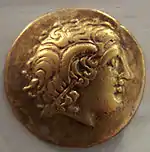Medulli
The Medulli were a Gallic tribe dwelling in the upper valley of Maurienne, in the modern region of Savoie, during the Roman period.
Name
They are mentioned as Medullorum by Vitruvius (late 1st c. BC),[1] Méd(o)ulloi (Μέδ<ο>υλλοι) by Strabo (early 1st c. AD),[2] Medulli by Pliny (1st c. AD),[3] and as Medoúllous (Μεδούλλους) by Ptolemy (2nd c. AD).[4][5]
The Gaulish ethnonym Medulli is generally derived from the Celtic root medu-, meaning 'mead, alcoholic drink' (cf. Olr. mid, MW. medd, OBret. medot), and thus may be translated as 'those inebriated by mead'. This interpretation is encouraged by the mention, in Vitruvius' De architetura, of a "kind of water" (genus aquae) drunk by the Medulli. Alternatively, Javier de Hoz has proposed to glose the name as 'those who lived in the middle', or 'in the border woods', by connecting it to the root *medhi/u- ('middle').[6][5]
Geography
The Medulli dwelled in the upper Maurienne valley, along the upper course of the Arc river, near the modern town of Modane. Their territory was located east of the Graioceli (themselves east of the Vocontii), north of the Brigianii and Quariates, west of the Segusini, and south of the Ceutrones (themselves south of the Allobroges).[7][8]
They belonged to the tribes governed by Cottius in Alpes Taurinae and were later integrated into the province of Alpes Cottiae.[8]
History
The Medulli were subjugated by Augustus (27 BC–14 AD).[8] They are mentioned in the Trophy of the Alps.[3]
According to Vitruvius, they were particularly prone to suffer from goitre.[8]
Among the Aquiculi in Italy and among the tribe of the Medulli in the Alps, there is a kind of water which causes goitre among those who drink it.
References
- Vitruvius. De architetura, 8:3:20.
- Strabo. Geōgraphiká, 4:1:11, 4:6:5.
- Pliny. Naturalis Historia, 3:137.
- Ptolemy. Geōgraphikḕ Hyphḗgēsis, 2:10:7.
- Falileyev 2010, s.v. Medulli.
- de Hoz 2005, p. 178.
- Talbert 2000, Map 17: Lugdunum.
- Dietz 2006.
Primary sources
- Pliny (1938). Natural History. Loeb Classical Library. Translated by Rackham, H. Harvard University Press. ISBN 978-0674993648.
- Strabo (1923). Geography. Loeb Classical Library. Translated by Jones, Horace L. Harvard University Press. ISBN 978-0674990562.
- Vitruvius (1934). On Architecture. Loeb Classical Library. Translated by Granger, Frank. Harvard University Press. ISBN 978-0674993099.
Bibliography
- de Hoz, Javier (2005). "Ptolemy and the linguistic history of the Narbonensis". In de Hoz, Javier; Luján, Eugenio R.; Sims-Williams, Patrick (eds.). New approaches to Celtic place-names in Ptolemy’s Geography. Ediciones Clásicas. pp. 173–188. ISBN 978-8478825721.
- Dietz, Karlheinz (2006). "Medulli". Brill’s New Pauly. doi:10.1163/1574-9347_bnp_e728780.
- Falileyev, Alexander (2010). Dictionary of Continental Celtic Place-names: A Celtic Companion to the Barrington Atlas of the Greek and Roman World. CMCS. ISBN 978-0955718236.
- Talbert, Richard J. A. (2000). Barrington Atlas of the Greek and Roman World. Princeton University Press. ISBN 978-0691031699.
Further reading
- L. Comby 1977, Histoire des Savoyards, Nathan
